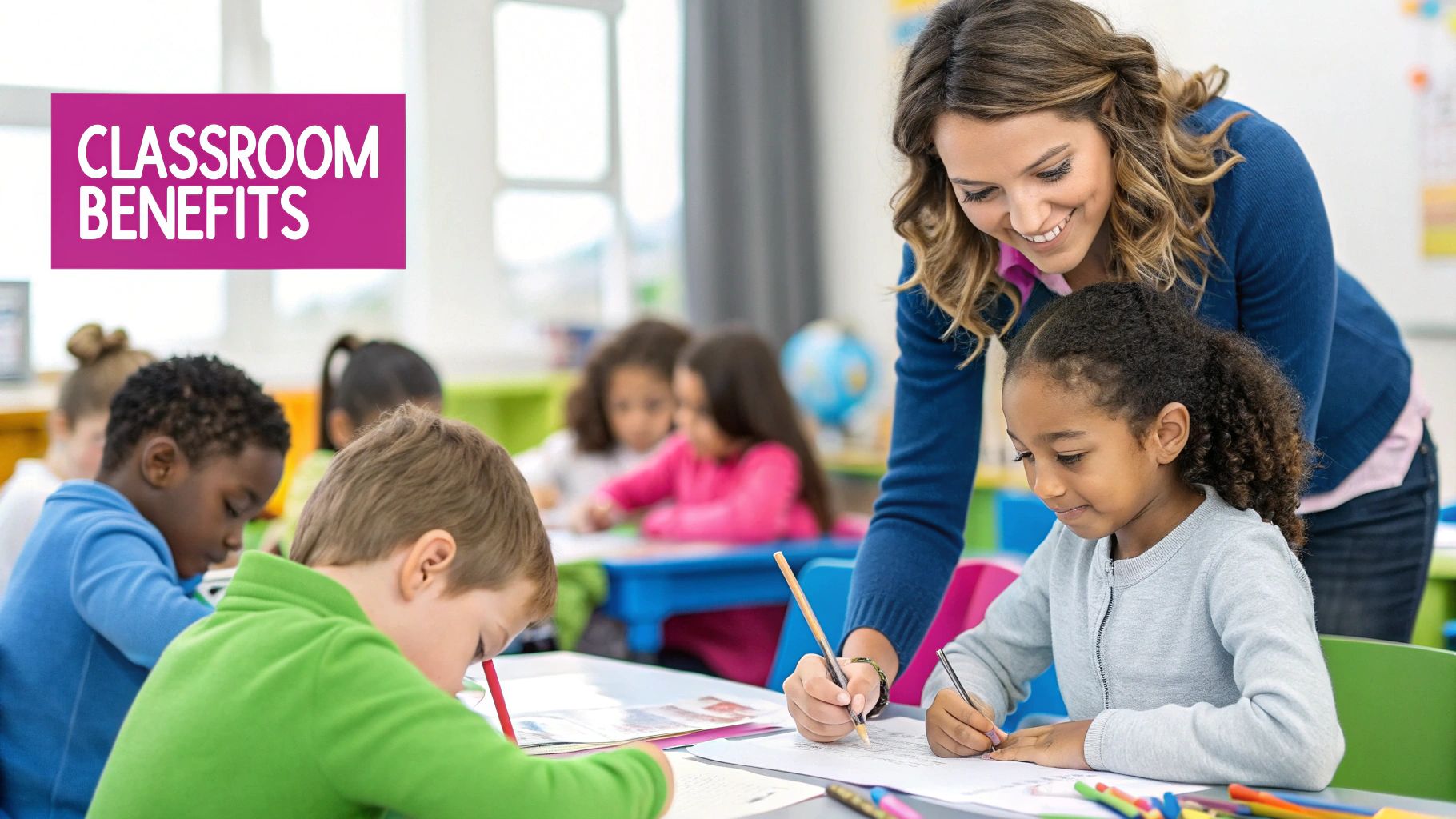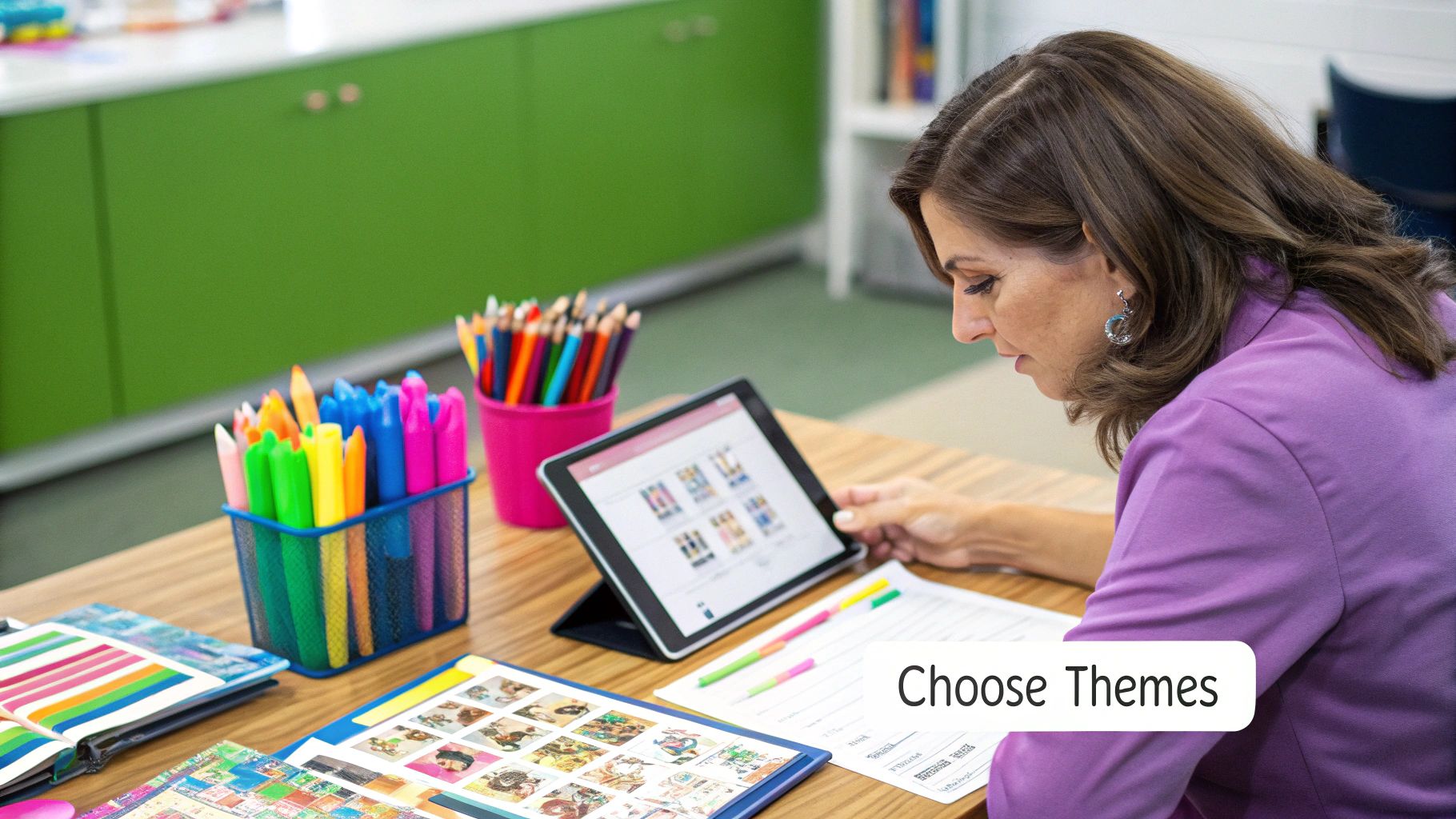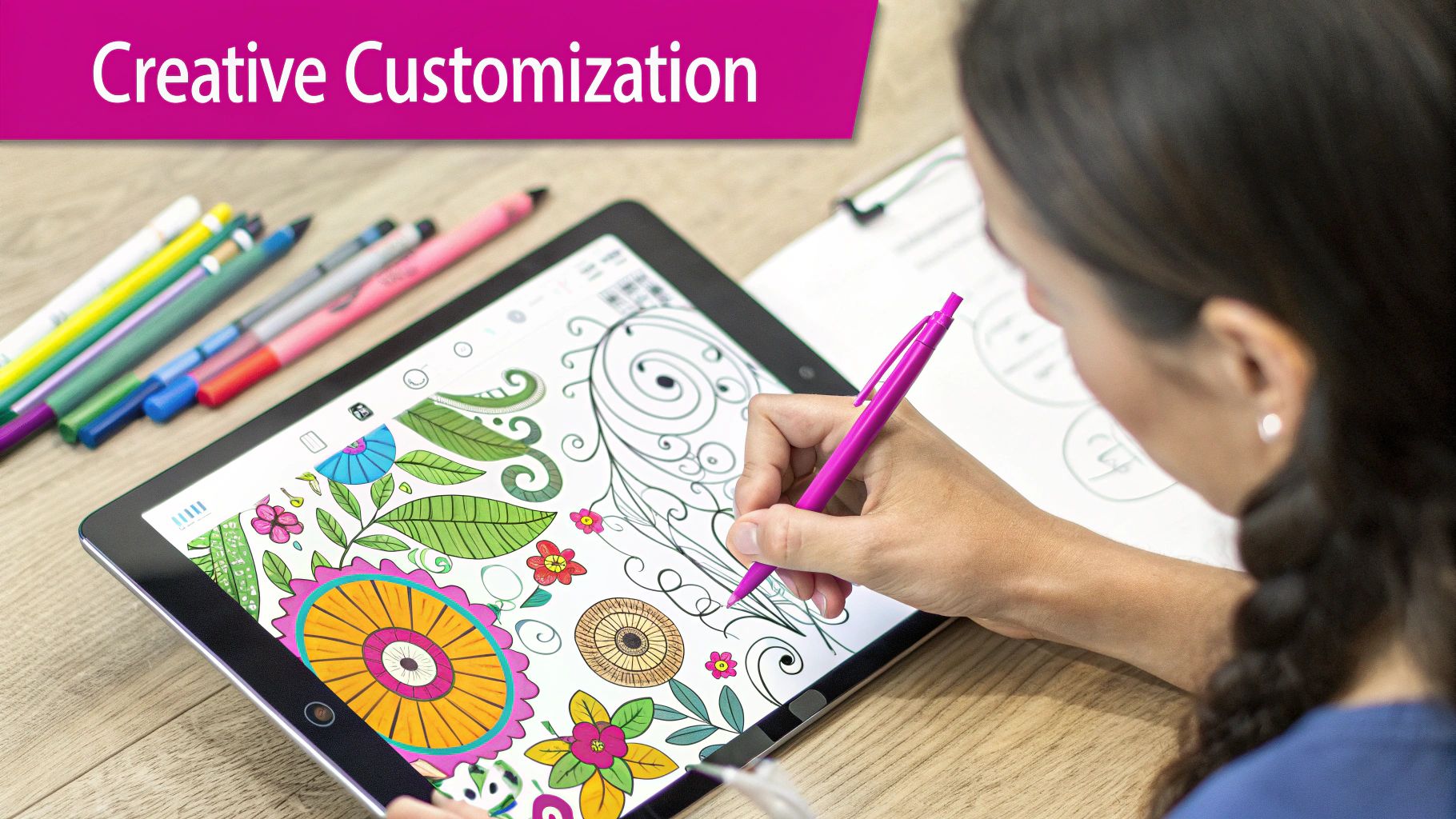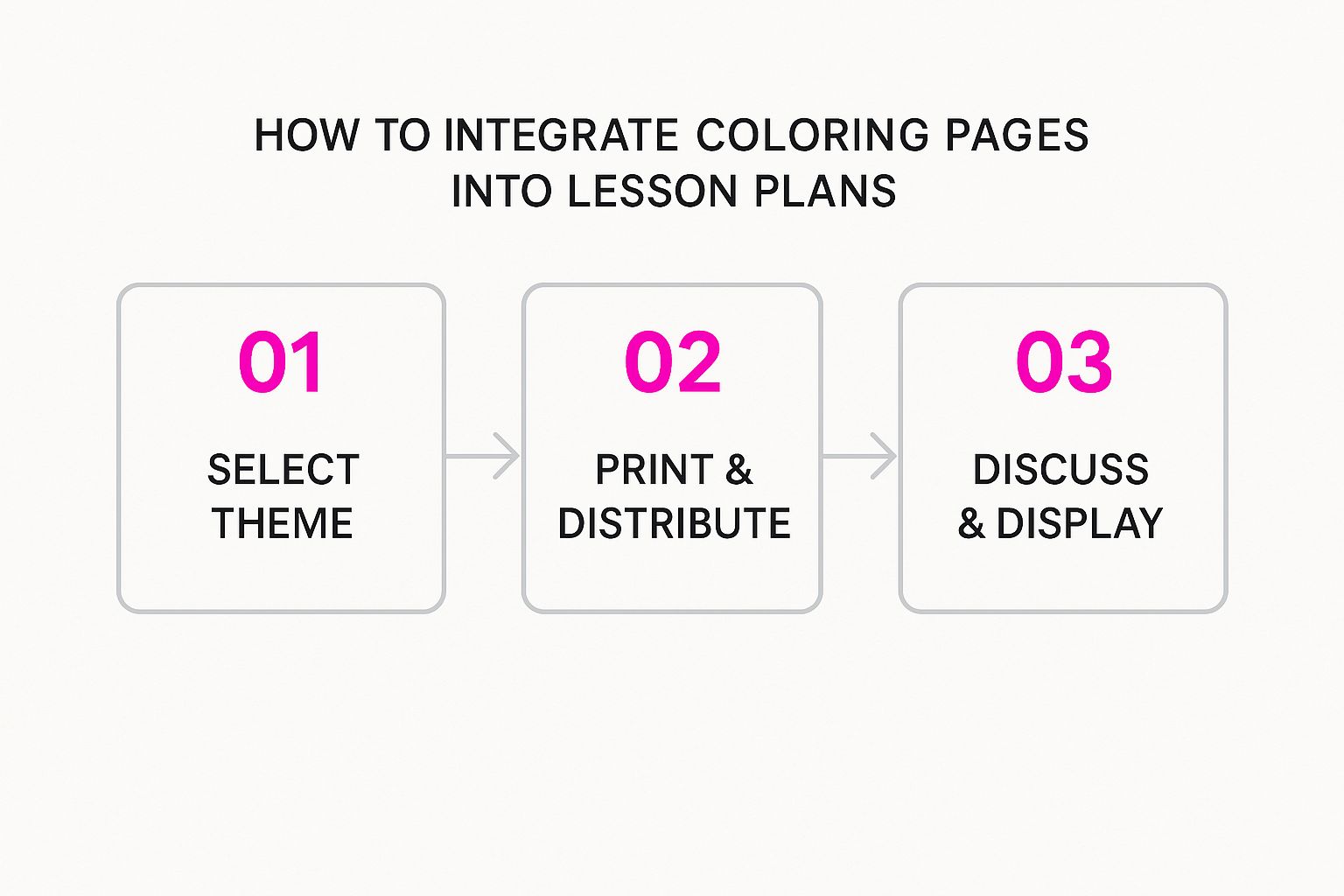
AI Coloring Pages for Teachers Made Easy

Aarav Mehta • August 4, 2025
Discover how to create custom AI coloring pages for teachers. A practical guide to making engaging classroom resources that students will love.
Let's be honest, searching for the perfect classroom worksheet can feel like a never-ending quest. You need something that fits right now's lesson, not just a generic activity. This is where AI-generated coloring pages completely change the game for teachers. In just a few minutes, you can create custom, curriculum-aligned activities that grab your students' attention and actually reinforce what you're teaching.
Imagine moving beyond clip art and creating visuals that perfectly match your lesson on historical figures, scientific diagrams, or even vocabulary words. It’s about making learning more engaging and, frankly, more memorable.
Why Custom Coloring Pages Are a Classroom Game-Changer

When you ditch the standard, one-size-fits-all worksheets, you can really shift the energy in your classroom. Creating coloring pages directly tied to your lessons isn't just about a filler activity; it's about building a powerful educational tool that feels intentional.
Think about it. Are you teaching a unit on ancient Egypt? Instead of another generic pyramid picture, you could instantly generate a detailed coloring page of the mummification process, a map of Nile River settlements, or a sheet featuring key hieroglyphs. Suddenly, a simple art activity is a visual anchor for core concepts.
Deeper Learning and Engagement
I've seen it time and time again: students connect more deeply with material that feels like it was made just for them. A custom coloring page becomes a fantastic focal point for discussion and review.
For example, after my students color a detailed diagram of a plant cell, they're far better prepared to label its parts and explain their functions. The physical act of coloring helps cement the visual information in their minds, making abstract topics much more concrete. It's a quiet, focused activity that genuinely improves retention.
This isn't just a classroom phenomenon. The adult coloring book market, a close cousin to what we're doing, was valued at USD 2.5 billion in 2024 and is projected to more than double by 2033. This boom shows a widespread appreciation for coloring's ability to boost focus and mindfulness—principles that are incredibly effective in a learning environment. You can read more about the growing market for coloring activities and see how it connects to education.
Key Takeaway: Custom coloring pages bridge the gap between creative expression and academic learning. They allow you to tailor activities to the specific vocabulary, concepts, and themes you are teaching at that very moment.
It's one thing to find a pre-made worksheet, but it's another to create one that perfectly aligns with your lesson. Here’s a quick look at why making your own is so much more effective.
Custom vs Generic Coloring Pages
| Feature | Custom AI-Generated Pages | Generic Pre-Made Pages |
|---|---|---|
| Relevance | Directly tied to your specific lesson plan, vocabulary, or theme. | Broad topics that may not align perfectly with your curriculum. |
| Engagement | Students connect with content that feels unique and purposeful. | Can feel like a generic "filler" activity. |
| Differentiation | Easily create simple or complex versions for diverse learners. | One-size-fits-all design, making differentiation difficult. |
| Speed | Generate unique pages in minutes, on-demand. | Requires searching through databases and websites. |
| Creativity | Unlimited possibilities for subjects, styles, and complexity. | Limited to what's already been created and published. |
The ability to tailor content on the fly makes custom pages a clear winner for a responsive and dynamic classroom.
Supporting Diverse Classroom Needs
One of my favorite things about generating my own content is the incredible potential for differentiation. You can create a whole range of sheets on the exact same topic to meet every student where they are.
- For younger students or those developing fine motor skills: Generate images with very bold, simple lines and big, open spaces. Think "a single, large dinosaur."
- For older students or those needing a challenge: Create intricate designs packed with detail, like a complex historical scene or a scientific illustration with tiny labels.
- For your early finishers: Keep a folder of exciting, themed pages ready to go. I love having sets like "scenes from Shakespearean plays" or "famous inventors and their creations" on hand.
This flexibility ensures every student can participate in a meaningful way. It transforms a single activity into a multi-level learning opportunity, making the task more approachable and enjoyable for everyone.
Getting Started with AI Image Generation Tools

Diving into a new piece of technology can feel like one more thing on an already-full plate. I get it. But creating AI-powered coloring pages is surprisingly straightforward, especially with modern tools like Bulk Image Generation. They're built for people who are educators, not software engineers.
The whole process really just starts with you describing what you need in plain English. Think of it as translating your lesson plan into a visual idea. The platform does all the complex work in the background, turning your words into a unique coloring sheet. You don’t need to be an artist or a tech wiz; you just need to have a clear idea.
Navigating the Interface with Confidence
The first time you open the platform, you’ll find a clean, simple layout. Your main focus will be the prompt box—that’s where you’ll type out what you want the AI to create. Don’t get hung up on writing the perfect prompt right away. The real magic happens when you start experimenting.
Let's try a quick warm-up. If you're working on the alphabet, you could type a prompt like: "coloring page of an apple for the letter A, simple bold outlines, for kids." This simple exercise immediately shows you how your instructions directly shape the final image.
Our Goal: To get you from an idea to a printable classroom resource in just a few minutes. Once you see how fast you can create something genuinely useful, you'll feel ready to tackle even more ambitious projects.
Of course, bringing these tools into the classroom often requires funding. It's worth exploring options for grant money for computers in education to help equip your school with the necessary hardware.
Preparing Your First Coloring Page Project
Before you start generating dozens of images, a little planning goes a long way. Think about an upcoming unit and what kinds of visuals would really make it click for your students.
A quick brainstorm might look something like this:
- List Your Core Concepts: What are the key terms or figures? For a science unit on the solar system, you might list "Mars," "Jupiter," "astronaut," and "rocket ship."
- Pick a Consistent Style: How do you want the pages to look? You might decide on "simple line art for toddlers" or something more detailed like "realistic illustrations for older students." A consistent style makes your materials look professional and cohesive.
- Think About Variations: Do you need to differentiate? You could plan for a basic version of an image and a more complex one to meet the needs of every learner in your classroom.
With a simple plan in hand, you're ready to go from making single images to producing an entire unit's worth of custom coloring pages for teachers. This is where you really start saving incredible amounts of time.
Crafting Prompts for Perfect Educational Coloring Pages

This is where the magic happens. The real power of an AI image generator isn't just the tech—it's how you translate your classroom idea into a prompt that delivers a perfect, printable resource. Think of it less like coding and more like giving crystal-clear directions to a very literal, very talented artist.
A vague idea like, “a coloring page of ancient Rome,” is a start. But it leaves way too much up to the AI's imagination. You might get a hyper-detailed battle scene or an intricate mosaic—neither of which is great for a kindergarten coloring activity.
A much better approach? Get specific. Something like, “coloring page of a Roman Colosseum, simple line art with bold outlines, no shading, for kids” gives the AI everything it needs: a clear subject, a distinct style, and the intended audience. That’s how you get a usable image on the first try.
The Anatomy of a Great Prompt
From my experience, the best prompts for educational coloring pages almost always nail three key components. Once you get the hang of combining them, you’ll have precise control over every image you create.
- The Subject: This is your what. Be as descriptive as you can. Don't just say "flower"; try "sunflower with a thick stem and two large leaves."
- The Style: This is the how. This part is absolutely critical for making pages that are actually colorable. Use terms like "simple line art," "coloring book style," "bold outlines," or "cartoon style."
- The Modifiers: These are your finishing touches. Think "for kids," "no background," "minimal detail," or "white background." They help clean up the image and remove unnecessary complexity.
The demand for these custom resources is exploding. The children's coloring and drawing market was valued at an estimated USD 608 million in 2025 and is poised for major growth. This isn't surprising, as more teachers use diverse coloring pages for teachers to bring interactive learning to subjects from science to history. You can discover more insights about the creative arts market on datainsightsmarket.com to see the trends driving this.
From Simple to Specific: A Real-World Example
Let's walk through how small tweaks can completely change your results. Imagine you’re teaching the life cycle of a butterfly and need a worksheet.
Your first attempt (the basic prompt):
coloring page of a butterfly
This will give you... well, a butterfly. It’ll probably be a nice one, but it's just a generic image. It doesn't really teach anything.
Now, let’s level up (the improved prompt):
coloring page of the butterfly life cycle with egg, caterpillar, chrysalis, and butterfly, simple line art for kids
See the difference? This prompt is a lesson plan in itself. It specifies every element you need to hit your learning objective. If you're ever feeling stuck on how to phrase things, our free AI image prompt generator is a great place to find inspiration and new ideas.
Here’s a look at the Bulk Image Generation platform, showing exactly where you’d type in these detailed prompts.

As you can see, the interface is clean and straightforward. You can easily plug in multiple prompts to generate an entire batch of custom coloring pages all at once, saving you a ton of prep time.
Key Takeaway: Specificity is your best friend. The more detail you feed the AI about the subject, style, and how you plan to use it, the closer you'll get to the perfect resource on the first go. Don't be shy about experimenting with different phrases and combinations to find what works for your classroom.
How to Generate and Customize Your Coloring Sheets
As any teacher knows, efficiency is everything. Making a single, perfect coloring page is one thing. But what if you could create an entire unit's worth of custom sheets in the time it takes to brew a cup of coffee? That's the real magic of bulk generation—producing dozens of unique, themed pages all at once.
The whole process kicks off with a simple CSV file, which is basically just a spreadsheet. Every row in this file becomes a specific instruction, or prompt, for a unique image you want the AI to create. It’s the perfect way to build out a whole library of resources in one go.
Let’s say you’re starting a unit on community helpers. Your CSV file might have rows for "coloring page of a firefighter putting out a fire," "coloring page of a doctor with a stethoscope," and "coloring page of a mail carrier delivering letters." You're essentially mapping out your entire lesson's visual aids in one clean, organized list.
Setting Up Your Bulk Generation File
Getting your CSV file ready is surprisingly straightforward. You only need a single column with a header, something like "prompt." Underneath that header, you just list every single coloring page idea you can think of.
This method opens up incredible possibilities for variation and differentiation with almost no extra work.
- Varying Complexity: In the same file, you could have prompts for a
simple cartoon bee for toddlersand adetailed anatomical drawing of a honeybee for older students. - Thematic Depth: A history unit could include prompts for key figures, famous battles, and important inventions, all generated in the same batch.
- Vocabulary Reinforcement: Imagine listing your weekly vocab words, each in a prompt like
coloring page of the word 'abundant' with fruit overflowing from a basket.
Once your list is good to go, you just upload it to the Bulk Image Generation platform. The tool gets to work, processing each row and creating a unique image for every prompt. This means you can spend just a few minutes setting up the file and come back to a complete library of custom teaching materials.
When you're ready to start designing your custom sheets, exploring platforms like the tnote.ai's editor can provide hands-on experience with different creation tools.
This handy infographic breaks down how you can take these newly generated sheets and put them right to work in your classroom.

The flow is seamless, moving from selecting your theme all the way to displaying the finished work. It shows just how easily these custom resources can slide into your existing lesson plans.
Managing and Selecting Your Images
Once the generation process finishes, you'll have a whole gallery of images waiting for you. Let's be real—not every single image will be a home run on the first try, and that’s perfectly okay. The trick is to generate a few more than you actually need.
A good rule of thumb is to create 10-15% more images than your final count. So, if you need 20 pages for your unit, aim to generate around 23-25. This little bit of buffer gives you plenty of great options to choose from, ensuring you only use the highest-quality visuals that are the best fit for your lesson.
From there, you can quickly scan the results, pick out your favorites, and download them. This entire workflow—from a simple text list to a folder full of ready-to-print coloring pages for teachers—turns what used to be a time-consuming chore into an efficient, and even creative, part of your lesson planning.
Bringing Your Custom Coloring Pages into the Classroom
You’ve designed your first batch of custom coloring pages—that's the exciting part. But the real magic happens when you bring them off the screen and into your classroom, transforming them from simple pictures into powerful teaching aids.
You don't need to throw out your lesson plans and start from scratch. It’s all about finding small but meaningful ways to weave them in. I’ve found these custom sheets are perfect as bell-ringers to get students settled and focused, or as a fantastic resource for those early finishers to keep them engaged without disrupting the class.
From Simple Activities to Core Lesson Tools
What I love most about these custom coloring pages for teachers is how flexible they are. A single coloring sheet can wear many hats during a lesson, all depending on how you frame it.
Take a coloring page of a Roman aqueduct, for example. It's so much more than just an art activity.
- Before the lesson: Hand it out as a "provocation." It immediately sparks curiosity. Students will start asking questions: "What is this?" "What was it for?" You've hooked them before the lesson even begins.
- During the lesson: As you explain the marvels of Roman engineering, students can color. This is a game-changer for visual learners, helping them anchor abstract concepts to a concrete image.
- After the lesson: The finished page becomes a quick, informal assessment. Have them label key parts or flip it over and write one sentence explaining its purpose.
This idea of using coloring for both focus and learning isn't just a classroom trick; it's a massive trend. The global adult coloring book market—which is closely tied to educational coloring—hit a value of USD 151.23 million in 2024 and is expected to almost double by 2030. This surge shows just how much people want screen-free activities that reduce stress and boost cognitive skills. You can read the full research about these market trends if you're curious about the data.
Key Insight: Don't relegate your coloring pages to just one part of the lesson. Use them at different stages—as an introduction, for reinforcement, or as a review tool—to get the most educational bang for your buck. One sheet, multiple uses.
Creative Classroom Implementation Ideas
Ready to try this out? Here are a few practical strategies I've seen work wonders, taking your coloring pages way beyond just filling time. These ideas connect the simple act of coloring to bigger learning goals, from literacy to social-emotional development.
A favorite of mine is to pair a coloring sheet with a writing prompt. After coloring a scene from a story we're reading, I'll ask students to write a few sentences about what might happen next. It’s a seamless way to link visual art with narrative skills. If you need some inspiration, exploring our guide to creating beautiful coloring pages can spark tons of thematic ideas.
Another great use is for building vocabulary. Let’s say you’re introducing the word "photosynthesis." Generate a sheet that includes all the visual elements—the sun, leaves, water. As students color each component, the abstract term becomes concrete and far more memorable.
Finally, think about setting up a dedicated calming corner in your classroom. Stock it with a variety of your custom-made, themed coloring pages. I like to have a mix of mandalas, nature scenes, and simple patterns. It gives students who are feeling overwhelmed a valuable, self-directed tool to regulate their emotions and quietly refocus before they're ready to rejoin the group.
Common Questions from Teachers Using AI
Getting started with AI to create classroom resources often brings up a few questions. I get it—it’s a new way of working. But you'll quickly find it’s far less intimidating than it seems. Let's walk through some of the most common things teachers ask when they begin making AI-generated coloring pages for teachers.
A lot of educators I talk to are initially worried about a steep learning curve. The good news is that modern platforms are built for busy people, not tech wizards. The whole idea revolves around writing simple descriptions, or "prompts," to tell the AI what you want.
You really don't need any special skills. If you can describe what you need for a lesson—like "a simple drawing of the water cycle"—you have everything it takes to create a great coloring page. Most teachers are genuinely surprised when they generate their first useful classroom resource in just a few minutes.
Can I Make Pages for Specific School Subjects?
Absolutely. In fact, this is where AI image generation really shines. You can finally stop trying to make generic worksheets fit and instead create visuals that are perfectly aligned with your exact curriculum.
Imagine you're teaching a lesson on historical figures. Instead of a generic picture, you could generate a coloring page of "Marie Curie in her laboratory, simple line art." Or maybe you need "a diagram of a Roman aqueduct with bold outlines for kids." This kind of specificity is almost impossible to find in pre-made coloring books, and it allows you to create materials that directly reinforce your lessons and vocabulary.
This precision helps students connect with the material in a much more meaningful way. The ability to create custom visuals on the fly is becoming a huge part of modern teaching. You can learn more about how creativity is evolving by exploring the latest AI image generation trends for 2025.
What Are the Copyright Rules for Classroom Use?
This is a fantastic and important question. When you create an image with an AI platform, you're generally granted broad rights to use it, especially for non-commercial, educational purposes like classroom activities.
Key Insight: Using the images you generate for printed classroom handouts, activities, and lesson aids is a standard and widely accepted practice. It's always a good idea to double-check the terms of service for the specific platform you're using, but you’ll find that creating coloring pages for your students falls well within the intended use.
And once you get comfortable with visuals, it's interesting to see what else AI can do. For instance, it's worth learning about how AI tools like text-to-speech can enhance student performance to get a bigger picture of AI's role in education.
How Do I Make Sure Pages Are Age-Appropriate?
You have total control here. The magic is all in your prompts—the text you write to describe the image. This is how you guarantee every coloring page is perfectly suited for your students' developmental level.
For example, here’s how you can adjust your prompts for different age groups:
- For Younger Students: Try adding phrases like "simple for toddlers," "bold outlines," "minimal detail," or "cute cartoon style." This tells the AI to generate images with big, easy-to-color areas.
- For Older Students: You can ask for more complexity with terms like "detailed illustration," "intricate patterns," "realistic shading," or even "anatomical drawing."
Here’s a pro tip: generate a few variations of the same idea. By making small tweaks to your prompt, you can produce a handful of different images and then pick the one that best matches your students' fine motor skills and attention spans.
Ready to stop searching and start creating? Bulk Image Generation puts the power of AI in your hands, allowing you to produce entire sets of custom coloring pages in minutes. Transform your lesson planning and bring your curriculum to life with visuals made just for your students. Start generating your first coloring pages for free today.